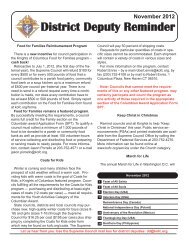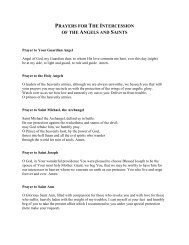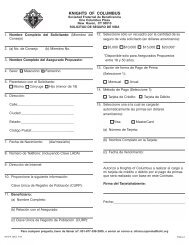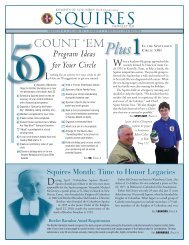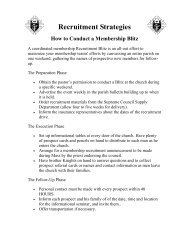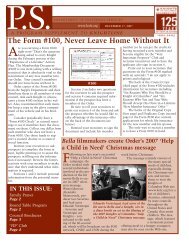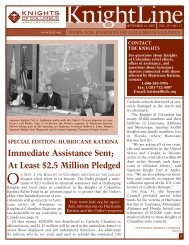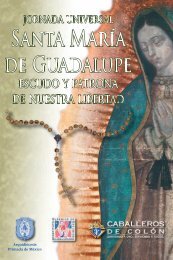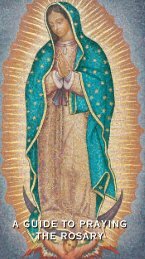CATHOLIC WORD BOOK - Knights of Columbus, Supreme Council
CATHOLIC WORD BOOK - Knights of Columbus, Supreme Council
CATHOLIC WORD BOOK - Knights of Columbus, Supreme Council
You also want an ePaper? Increase the reach of your titles
YUMPU automatically turns print PDFs into web optimized ePapers that Google loves.
most churches, chapels and in some other<br />
places, beneath small crosses. A person<br />
making the Way <strong>of</strong> the Cross passes before<br />
these stations, or stopping points, pausing<br />
at each for meditation. If the stations are<br />
made by a group <strong>of</strong> people, only the leader<br />
has to pass from station to station. A<br />
plenary indulgence is granted to the<br />
faithful who make the stations, under the<br />
usual conditions: freedom from all<br />
attachment to sin, reception <strong>of</strong> the<br />
sacraments <strong>of</strong> penance and the Eucharist,<br />
and prayers for the intentions <strong>of</strong> the pope.<br />
Those who are impeded from making the<br />
stations in the usual manner can gain the<br />
same indulgence if, along with the<br />
aforementioned conditions, they spend at<br />
least a half hour in spiritual reading and<br />
meditation on the passion and death <strong>of</strong><br />
Christ. The stations originated remotely<br />
from the practice <strong>of</strong> Holy Land pilgrims<br />
who visited the actual scenes <strong>of</strong> incidents<br />
in the Passion <strong>of</strong> Christ. Representations<br />
elsewhere <strong>of</strong> at least some <strong>of</strong> these scenes<br />
were known as early as the 5th century.<br />
Later, the stations evolved in connection<br />
with and as a consequence <strong>of</strong> strong<br />
devotion to the Passion in the 12th and<br />
13th centuries. Franciscans, who were<br />
given custody <strong>of</strong> the Holy Places in 1342,<br />
promoted the devotion widely; one <strong>of</strong><br />
them, St. Leonard <strong>of</strong> Port Maurice, became<br />
known as the greatest preacher <strong>of</strong> the Way<br />
<strong>of</strong> the Cross in the 18th century. The<br />
general features <strong>of</strong> the devotion were fixed<br />
by Clement XII in 1731.<br />
Statutes: Virtually the same as decrees (See<br />
separate entry), they almost always<br />
designate laws <strong>of</strong> a particular council or<br />
synod rather than pontifical laws.<br />
Stigmata: Marks <strong>of</strong> the wounds suffered by<br />
Christ in his crucifixion, in hands and feet<br />
by nails, and side by the piercing <strong>of</strong> a<br />
lance. Some persons, called stigmatists,<br />
have been reported as recipients or<br />
sufferers <strong>of</strong> marks like these. The Church,<br />
however, has never issued any infallible<br />
declaration about their possession by<br />
anyone, even in the case <strong>of</strong> St. Francis <strong>of</strong><br />
Assisi whose stigmata seem to be the best<br />
substantiated and may be commemorated<br />
in the Roman Rite liturgy. Ninety percent<br />
<strong>of</strong> some 300 reputed stigmatists have been<br />
women. Judgment regarding the presence,<br />
significance, and manner <strong>of</strong> causation <strong>of</strong><br />
stigmata would depend, among other<br />
things, on irrefutable experimental<br />
evidence.<br />
Stipend, Mass: An <strong>of</strong>fering given to a<br />
priest for applying the fruits <strong>of</strong> the Mass<br />
according to the intention <strong>of</strong> the donor.<br />
The <strong>of</strong>fering is a contribution to the<br />
support <strong>of</strong> the priest. The disposition <strong>of</strong><br />
the fruits <strong>of</strong> the sacrifice, in line with<br />
doctrine concerning the Mass in particular<br />
and prayer in general, is subject to the will<br />
<strong>of</strong> God. Mass <strong>of</strong>ferings and intentions were<br />
the subjects <strong>of</strong> a decree approved by John<br />
Paul II and made public Mar. 22, 1991: (1)<br />
Normally, no more than one <strong>of</strong>fering<br />
should be accepted for a Mass; the Mass<br />
should be <strong>of</strong>fered in accord with the<br />
donor’s intention; the priest who accepts<br />
the <strong>of</strong>fering should celebrate the Mass<br />
himself or have another priest do so. (2)<br />
Several Mass intentions, for which<br />
<strong>of</strong>ferings have been made, can be<br />
combined for a “collective” application <strong>of</strong> a<br />
single Mass only if the previous and<br />
explicit consent <strong>of</strong> the donors is obtained.<br />
Such Masses are an exception to the<br />
general rule.<br />
-67-





